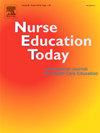Comparison of learning outcomes: Team-based vs. problem-based learning with high-Fidelity simulation in a critical care nursing course—a mixed-methods design
IF 4.2
2区 医学
Q1 EDUCATION, SCIENTIFIC DISCIPLINES
引用次数: 0
Abstract
Background
Few studies have evaluated the comparative effectiveness of team-based learning (TBL) and problem-based learning (PBL) combined with simulation in nursing education.
Objective
This study aimed to compare the learning outcomes of TBL versus PBL, incorporating high-fidelity simulation (HFS) in a critical care nursing course.
Methods
This study used a mixed-methods design with convenience sampling. Senior baccalaureate nursing students from a university of science and technology were recruited. Participants were randomly assigned to the TBL or PBL group by class, each receiving their respective teaching strategies combined with HFS. Course outcomes were assessed using a variety of instruments, including a learning assessment (shock knowledge, Advanced Cardiovascular Life Support knowledge, and a final test), the Satisfaction with Simulation Experience Scale (SSES), the Confidence Scale, the Emergency Preparedness Simulation Learning Experience Scale (EPSLES), the Learning Experience Questionnaire, and a demographic questionnaire.
Results
A total of 173 senior nursing students were included. A One-way ANCOVA was utilized to control for pre-test and midterm test scores when comparing the learning effects. The analysis revealed a statistically significant difference in post-test shock knowledge scores between the two groups (F = 4.51, p = 0.04). The TBL group achieved significantly higher post-test scores compared to the PBL group. In contrast, following the HFS program, the PBL group showed significantly higher mean scores on the SSES and EPSLES than the TBL group (t = 2.09, p = 0.04; t = 2.59, p = 0.01, respectively).
Conclusion
Our study evaluated the effectiveness of mixed teaching strategies in a critical care nursing course. Findings indicate that both TBL and PBL enhance learning outcomes. The TBL group demonstrated superior performance on the learning outcomes test, while the PBL group excelled in simulation satisfaction and emergency simulation learning experiences. These results provide insights for selecting appropriate teaching strategies in intensive care education for nursing students.
学习结果的比较:高保真模拟重症护理课程中基于团队与基于问题的学习-混合方法设计
基于团队的学习(TBL)和基于问题的学习(PBL)结合模拟在护理教育中的效果比较研究很少。目的采用高保真模拟(high-fidelity simulation, HFS)方法对危重病护理课程中TBL与PBL的学习效果进行比较。方法采用方便抽样的混合方法设计。招募某理工大学护理系本科毕业班学生。参与者按班级随机分为TBL组或PBL组,每个组接受各自的教学策略结合HFS。课程结果使用多种工具进行评估,包括学习评估(休克知识、高级心血管生命支持知识和最终测试)、模拟体验满意度量表(ses)、置信度量表、应急准备模拟学习体验量表(EPSLES)、学习体验问卷和人口统计问卷。结果共纳入173名护生。在比较学习效果时,采用单因素方差分析(One-way ANCOVA)来控制前测和期中考试成绩。分析显示,两组测试后休克知识得分差异有统计学意义(F = 4.51, p = 0.04)。与PBL组相比,TBL组获得了显著更高的测试后得分。相比之下,在HFS方案实施后,PBL组的ses和EPSLES平均得分显著高于TBL组(t = 2.09, p = 0.04;T = 2.59, p = 0.01)。结论本研究评价了混合教学策略在危重病护理课程教学中的效果。研究结果表明,TBL和PBL都能提高学习效果。TBL组在学习成果测试上表现优异,PBL组在模拟满意度和应急模拟学习体验上表现优异。这些结果为护生重症监护教学策略的选择提供了参考。
本文章由计算机程序翻译,如有差异,请以英文原文为准。
求助全文
约1分钟内获得全文
求助全文
来源期刊

Nurse Education Today
医学-护理
CiteScore
6.90
自引率
12.80%
发文量
349
审稿时长
58 days
期刊介绍:
Nurse Education Today is the leading international journal providing a forum for the publication of high quality original research, review and debate in the discussion of nursing, midwifery and interprofessional health care education, publishing papers which contribute to the advancement of educational theory and pedagogy that support the evidence-based practice for educationalists worldwide. The journal stimulates and values critical scholarly debate on issues that have strategic relevance for leaders of health care education.
The journal publishes the highest quality scholarly contributions reflecting the diversity of people, health and education systems worldwide, by publishing research that employs rigorous methodology as well as by publishing papers that highlight the theoretical underpinnings of education and systems globally. The journal will publish papers that show depth, rigour, originality and high standards of presentation, in particular, work that is original, analytical and constructively critical of both previous work and current initiatives.
Authors are invited to submit original research, systematic and scholarly reviews, and critical papers which will stimulate debate on research, policy, theory or philosophy of nursing and related health care education, and which will meet and develop the journal''s high academic and ethical standards.
 求助内容:
求助内容: 应助结果提醒方式:
应助结果提醒方式:


